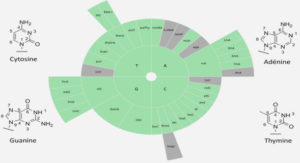Racial Identity in Claude McKay’s Home to
Harlem
The Notion of Double Consciousness
The Characters and the Illusion of Belonging
The Civil war did not only pave the way to the end of racism in the United States, but it has also given rise for a new sentiment of belonging in white mainstream, for the AfricanAmerican. Black People, after having been affranchised and freed from the terror of slavery, isolation and discrimination, were trying to emerge in American society. Identity and perception of psychological differences were being redefined. African-Americans were beginning to consider themselves as entire part of the society. New events helped to reshape African-American position in the United States. With World War I, African American groups saw a way and an opportunity to win the respect of their white compatriots. Slavery was ended, but racism and discrimination persisted in the white society. Black people engaged in a new battle, to be respected, to enjoy the same rights as white citizen and at last to show their worthiness, in order to gain equal treatment in the United States. This new African- American mentality is reflected in Claude McKay’s character in Home to Harlem, Jake, Jake Brown represents the polarities that African-American wanted to bridge in the period following the slavery .In enlisting in the United States army, and Jake had the ambition to bridge the gaps and to break with old mentalities that were prevailing in the society. His main goal is to achieve the same things as white citizen and compatriots, meaning to fight and defend the interests of the country and, by the way represents its image. Fighting for the United States is inevitably to share its politics, to act and to think like white mainstream society. You become soldier because you see yourself in the army you are enlisting, in the idea you defend and in the country you protect. This mentality, being considered as the beginning of belonging, began to rise and develop in African-American group, a group that, for a long time, is relegated to the bottom of the American social pyramid. Instead of viewing and constructing mainly on their difference, meaning their race, their culture and their way of living, Black people in the United States focus mainly on the idea developed by white mainstream, they begin to be attracted by the same things, the same beliefs and, at the same time, to live in the same way. Ernest James Gaines’s protagonist, Jefferson, he exemplifies a young black male who has internalized into self –hatred the hatred shown him by white racist. Because of his courtappointed attorney’s racist remark, he sees himself as a beast-not worthy of dignity and respect due all human beings. His lack of self- worth and self-esteem is a major factor in his apathy and defeatist attitude. In order to reach him, Grant must first break through the barrier of his self-hate. In effect Jefferson feels that he was not condemned to die like a man, but to be destroyed like a beast. Worse, he believes that he is no better than a dumb animal and that deserves to die, since he sees his life as worthless. And Jake Brown to interact with people different from him, is the illusion of not only being black , meaning of not only being part of black community , but it is the fact of considering himself as being citizen of a society in which different groups gather. The American: a society in which racism is no longer allowed, a society in which white people were no longer considered as the master, but just as a citizen like other citizen from different groups. These Black people that express themselves without limits, that contribute to the welfare of their community, that bring a new vision, a new image of what is really their thoughts of what should be the society after centuries of persecutions and disillusions; William Du Bois and his notion of Double Consciousness, Aaron Douglas and his paintings, Louis Amstrong and his way of singing that expressed the vitality and the emergence of a new society, United States for everyone. American society after slavery meant many things to many people. For some black people, they were living in a country in which they have known all kind of misfortunes and in which they will never be considered as an entire part of the society and that there will never be equal treatment .For others, they were facing a new dynamic in the society that allows them to think that there will be racial solidarity and social progress, and that black people as white people can be treated equally and interact. This last belief can be considered as the illusion of belonging. Claude McKay introduces to the readers a young black seeking to integrate and develop his identity focusing not only on his black community, but also in the white society, Jake Brown .He enlisted in the army because he considers himself as an American citizen, regardless of race and culture. On the other hand Gaines’s narratives involve characters attempting to resist dominant power systems inhibiting their rights while concurrently upholding values of place .Such a depiction does not encapsulate the inherent contradiction between place and identity formation .William Norton’s Cultural Geography asserts that 14 places must be “understood as sites of power struggles , displacements ,and contestations” Norton’s statement makes it clear that no identity , especially and identity based on ideals of particular place, can be formed without encountering place as a site of conflict . In Gaines’s A Lesson Before Dying, this conflict involves African-American males developing affirmative identities in a place that does not support the formation of such identity. Double Consciousness is a concept that Du Bois first explores in 1903 publication, “The Souls of Black Folk”, Double Consciousness describes the individual sensation of feeling as though your identity is divided into several parts, making it difficult or impossible to have one unified identity Du Bois spoke of this within the context of race relations in the United States. He asserted that since American Blacks have lived in a society that has historically repressed and devalued them that it has become difficult for them to unify their black identity with American identity. Double Consciousness forces blacks to not only free themselves from their own unique perspective, but to also view themselves as they might be perceived by the outside world. This is what Du Bois spoke of in the above passage when he talked about “The Sense of looking at one’s self through the eyes of others”. As a result, blacks can suffer from a damaged Self- image shaped by the perceptions and treatment of white people. Black life in return can easily become shaped by stereotypes perpetuated by mainstream white culture. According to Du Bois the prejudices of white people elicit “Self-Questioning, Self- disparagement, and lowering of ideals” among black peoples. The internalization of anti-black sentiment from the outside world thus begins to shape the black American experience. Though the concept of Double Consciousness Du Bois becomes better able to explore the social problems he studied in his earlier work “The Philadelphia Negro”. Double Consciousness cites the example of the black artisan in “The Souls of Black Folk”, conflicted between producing goods that reflect his unique perspective and life experience and goods are marketable and acceptable to a broader population he is engaged in a battle of double aims by working to create what is the best expression of himself he will be deemed unsuccessful he fails to express himself and in some ways may appear to be rejecting his True Self. This example exemplifies the black struggle to unite the different components of their identity. Double Consciousness is still very relevant to contemporary society, while many people would like to argue that we live in a post-racial society, there are still many inequalities based upon race that make it difficult for black Americans to reconcile their identities as blacks and as Americans . Our media sells us images of black men as athletes, 15 rappers or criminals and as a result white America perceives black men as such and young black males see these limited paths as their only option for advancement. This is just one illustration of how the media, which is largely dominated by White executives, continues to assume the role of shaping the perceptions that blacks have of themselves (and that whites have of blacks).
Jake and Jefferson and the Theory of Internalization
Stage The fact that the idea of color-blind has for a long time imposed limitations and restrictions to some communities , especially black people community, has made them become aware of their difference from the white mainstream civilization. Naturally, black people in the United States developed an idea of self-identification that consists of exploring their culture and heritage. Psychologically, slavery and racism has played a great role in the rejection of white culture. Slavery and racism have caused a great trauma in blacks and, even if it was ended, the society was not entirely opened to African- American and other kinds of limitations and exploitations have been created and developed by the society in order to prevent them from enjoying the same opportunities that white people were enjoying, and that to perpetuate their domination and exploitation. For many, the freedom of blacks were a threat to the society, for their culture and beliefs did not correspond and were totally different. In addition to the limitations23 of the white exclusions rules against black people, the living conditions of blacks were still limited and controlled. Among the African-American community, there were another part or group that faced limitations and exclusion from both African-American and white people, black biracial people. Black light skinned faced many problems in their everyday interactions. Most of them were excluded and faced punitive relationship with the system, because of their belonging in the white color or culture, even if it is partially. Light –skinned women, as materialized in the character of Vivian find problems to identify themselves in one culture. Vivian is lighter skinned than most of the black people in Bayonne, which immediately attracts the interest of the other black characters .And, later, Grant thinks to himself that mulatto’s people of mixed racial heritage despite dark-skinned black people as much as white people do. Even though mulattoes are equally the victims of racism banned from white bars and restaurants, forbidden from holding high paying jobs, they try to act more like whites in their hatred of darker skinned people. Naturally these limitations have caused a re-exploration24 of their culture, tradition and beliefs .African American experience and history during and the years that followed the 23 https://www.britannica.com/event/Jim -Crow-Law 24 http://www.historytoday.com/chery1-wall/history-harlem-renaissance -history From Ernest Gaines’s earliest published works of the late 1950s and 60s to his most recent novel, A Lesson Before Dying , Gaines consistently writes about 20 abolishment of slavery have made them see how their future will be constructed. A construction of their identity has inevitably to pass through an increase of Self-esteem and mingle and interaction with one’s community .Self-esteem is necessary to the development of one’s identity and personality. It can be considered as the start of the process of positive identity development and construction. For many black people and researchers, the Harlem Renaissance movement is the starting point of African-American community definition of identity after many years of oppression and limitations. The movement has helped shape the role and place of black heritage and culture in their struggle for recognition and respect in a white mainstream society. During the Negro Renaissance period, many black participated to the improvement of their culture through their creation .Many artists, singers, painters and writers have shown how their culture was rich, and how an exploration of their culture could help them to emerge. Both Home to Harlem and A Lesson Before Dying were dealing with the redefinition of African American’s Identity which is the core issue in the two books ,even though their approaches and stories are different ,they both appear to share one theme and line of thought , the construction of black racial identity. One thing that was necessary for black people was to emphasize on their difference by creating their identity, to explore and celebrate their cultural heritage because racial and cultural identity is developed over time. It requires many elements. The Color blind policy, as developed in the 1920s, aimed to treat other communities differently just due to their color and traditions and to stress the difference. Stripped of their humanity, their names and social status, African Americans strangely creep inside canonized White narratives in which they act as contrasting images for defining White Heroes, in these works, the authorial focus has always been on the White protagonist’s quest, whose heroism is narcissistically highlighted by a black presence” playing “in the background. The Internalization Stage can be defined as the fact Black People to develop their identity focusing on black empowerment, the individual with the bicultural identity accept blackness and another cultural orientation and individual who internalizes a multicultural identity accepts blackness and other cultural orientations. Quoted in Henry louis Gates ed Writing Race in the difference it Makes “Race, Writing and Difference ( Chicago University of Chicago Press, 1986)The word in language is half someone’s else it becomes” one’s own “only when the speaker populates it with his own intention, his own accent when he appropriate the word adapting it to his own semantic and expressive intention, Prior to the moment of appropriation the word does not exist in a neutral and impersonal language …but rather it exists in other people’s mouths in other people’s contexts ,serving other people’s intentions ;it is from there that one must take the word and make it one’s own ( Mikhail Bakhtin,” Discourse in the Novel” ) If we must die let it be not like a hogs. Hunted and penned in an inglorious spot…If we must die, oh let us nobly die, so that our precious blood may not be shed in vain… ( Claude McKay,” If We Must Die”) Black men who faced the problem of being denied the dignity and self –worth found in the status of” manhood”. In A Lesson Before Dying Gaines again picks up this theme as the narrator of the story, Grant Wiggins, a black college educated school teacher, takes on the responsibility of convincing Jefferson a non-educated black laborer who has been sentenced to death for a murder he didn’t commit, that Jefferson is indeed a” man” and not a” hog” as his White Attorney declared as part of his defense strategy. The Internalization stage is a stage that have found the ways to translate their personal sense of race into a plan of action or general sense of commitment to the concerns of their own race as a group. This is sustained over time. Their race becomes the point of departure for discovering the universe of ideas, cultures and experiences beyond their own race, in place of mistaking their race as the universe itself. Often a person moves from one stage to the next, only to revisit an earlier stage as the result of a new encounter experiences .Though the later experience of the stage may be different from the original experience. With sensual, often brutal accuracy, Claude McKay traces the parallel paths of two very different young men struggling to find their way through the suspicion and prejudice of American Society. At the same time, this stark but moving story touches on the central themes of the Harlem Renaissance, including the urgent need for unity and identity among blacks. Jake Brown, the protagonist of Home to Harlem, deserts the U.S Army during World War I and lives in London until a race riot inspires him to return to Harlem. On his first night home, he meets the prostitute Felice, For whom he spends much of the rest of the novel searching .Amid his adventures in Harlem, a gallery of rough, lusty, heavy-drinking characters appear to vivid effect .While working as a dining –car waiter, Jake encounters another point of view in 22 Ray, a pessimistic college-educated Haitian immigrant who advocates behavior based on racial pride The Harlem Renaissance which has garnered little scholarly attention to date, thesis statement: 25“Both Ernest James Gaines and McKay wrote from a context which invested the dominant white culture with more value than its black counterpart.” Although McKay shows himself as aware of black stereotypes as Ernest James Gaines but he sometimes challenges them explicitly. The trouble, however, is that McKay’s construct of blackness depends to a far greater degree on an adherence to the dominant white paradigm than the author himself seems aware of: he has internalized the white value system of his other. Constructing the black Self on the stage of the white other, as Frantz Fanon say, proves perpetually problematic.”
DEDICATION |





